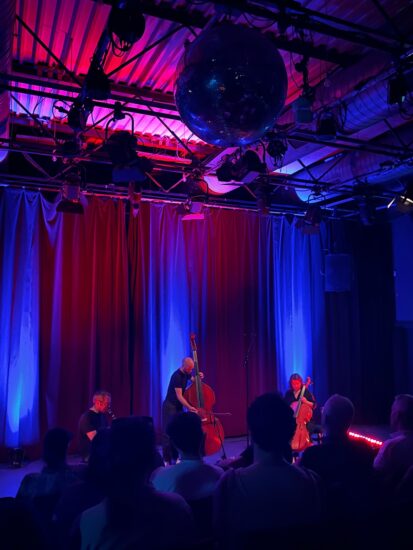Nestled in one of Köln’s oldest parks, hidden behind a popular restaurant and sprawling beer garden, is a 120-seat theater which has been a center for the city’s innovative improvisers for close to 40 years. Stadtgarten Köln also presents pop, dance and chamber music, but a contract between the city and the Initiative Kölner Jazz Haus E.V. has cemented the building as a home for jazz in its many popular and challenging forms.
On June 30, those listening challenges were serious, and the rewards for perseverance and contemplation considerable. Bassist Stefan Schönegg, joined by cellist Judith Hamann and clarinetist Michael Thieke, played a slow-moving, hour-long meditation on and around a single note.
Schönegg is a part of the NICA Artist Development program, named after renowned jazz benefactor Pannonica de Koenigswarter. (Thelonious Monk paid tribute to her in his composition “Pannonica.”) Through three-year fellowships, the organization offers professional development to artists who have made steps toward establishing a performance practice and career. The NICA program, including a concert series, is housed within the somewhat sprawling Stadtgarten building.

The black-box performance space is quiet (a smaller room and modest outdoor stage are also parts of the facility). On the night of the 30th, blue lights bounced off the black curtain at the rear of the stage as dim red lights lined the floor at either side. The trio entered, and after an extended silence Schönegg introduced a single, sustained note in the upper register. More silence followed and the note was repeated. On the third iteration, all three played, setting about forming a loose, one-note canon.
After a long five minutes, an octave was introduced on the clarinet, then the interval split again. Improvisation seemed to come primarily in durations of sounding and silence. Sustained tones were held for 15 or 20 seconds, sometimes overlapping. Pauses were even longer.
They proceeded apace for close to half an hour, working from a single page of score. After a considerable pause a new section began, on a single note again but held together with the soft entreating of breath and bow. Hamann in particular played with delicacy, applying just enough tension to sound and release tones. Thieke jumped more frequently to harmonic relations than the others.
Schönegg was the linchpin, holding concept to task. They gradually filled more of the space, creating an understated climax. A final section returned (it seemed) to the tonic, more pronounced this time, a recapitulation that grew in presence, a harmonic structure that had thus far been implied at best.
By this point in time, the expectations for expectation-free, intention-free music — whatever agenda one might project, or ad hoc labels used to characterize the musical state of near-nothingness — are misbegotten. The stilled mind starts to graft simple melodies onto the gaps, then catches itself. How are we, the 16 or so of us in this room, to listen?
Can one be disappointed by such an experience? Can one such evening be ranked as better or worse than the last? In that regard, this extreme minimalism, which has gone by different names, is the same as any, as all musics, and so the answer is yes, it can be perceived as better or worse. Personal preferences and perceptions come into play. One might like surprise, another the sense of internal structure.
This piece, this performance, on this night had (at the risk of invoking an old Monty Python routine) a nice, woody sound: bodily and visceral, reed and horsehair, ASMR improv. It was introverted, almost isolationist, although perhaps to another pair of ears communal, like a Quaker meeting. It was deeply engaging, so long as one was open to being engaged.
An hour after they’d begun, they fell silent a final time, heads bowed. Schönegg returned his bow to its holster before signalling an end with a soft smile. JT